
In this tutorial I’m going to show you 6 ways to use parchment paper or wax paper to decorate cakes! To watch the video version of this tutorial, scroll down to the bottom of the page.
1. Perfectly neat sprinkle borders
Place a frosted cake on a baking tray, which will catch any falling sprinkles. The frosting needs to have set for this so that it’s firm and no longer sticky. I like to chill my cakes in the fridge for an hour to set the frosting.

Wrap a piece of parchment paper around the cake so that it blocks off the area above where you want the sprinkles to stop. You can pin the parchment in place or if there’s any condensation on the outside of the cake, if you’ve moved it from the fridge to room temperature, the condensation might be enough to make the parchment stick in place. Pour your sprinkles around the base of the cake.
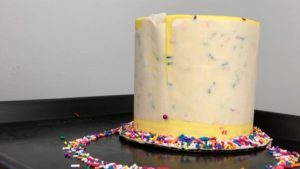
Use an

Peel the parchment paper off to reveal a neat sprinkle border!
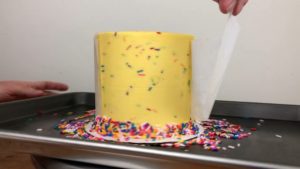
Click here for the full tutorial on this cake and 9 other epic rainbow cakes!

2. Make shapes on the sides of cakes
Draw a shape onto parchment paper and cut it out to make a homemade stencil.
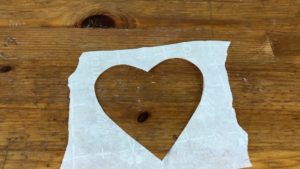
Press the shape against a chilled cake (smooth frosting rather than textured frosting works best for this) and you can pin it into place to hold it still. The frosting on the cake must have set before you do this, otherwise the parchment wills stick to it and pull the frosting off when you remove the parchment.
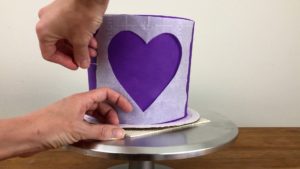
Spread buttercream over the shape, spreading from the outside towards the middle of the shape to make sure you don’t accidentally push buttercream underneath the edges of the shape, which would smudge the outline of the shape.
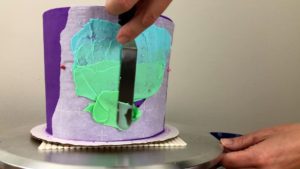
I’ve made a pattern within this heart using a chopstick and I cover the details in my tutorial on cake decorating with cutlery. Smooth the buttercream with a frosting smoother, scraping until the buttercream is as thick as you want it to be. Here, for example, I’ve scraped until I can see the purple frosting through the colours of the buttercream shape.

Peel the parchment off to reveal a neat shape underneath!

If any buttercream got underneath your stencil you can gently scrape it off with a toothpick. Because the frosting of the cake is cold and hard, you won’t damage it with the toothpick.
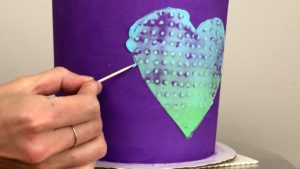
Parchment stencils aren’t the best quality but they’re cheap and easy to make and create beautiful results!

A variation of this technique is to make a sprinkled shape. After spreading buttercream over the stencil and scraping off any excess to leave just a thin layer, press sprinkles into the frosting to fill the shape. Do this on a baking tray to catch any falling sprinkles.

When you peel the parchment stencil off, the shape on the cake will be completely filled with sprinkles!

For more Valentine’s Day cake decorating ideas click here!
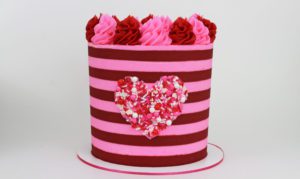
3. Make flowers to decorate cakes or cupcakes
For these flowers you’ll need a petal tip, which can be straight (e.g. #125) or curved (e.g. #61), like either of these tips in the photo.
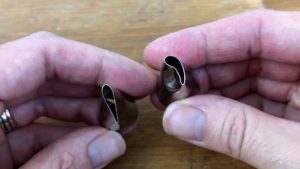
You’ll need a flower nail and little squares of parchment paper, which you can buy pre-cut or just cut out yourself from a roll of parchment paper. Squeeze or spread a little dot of buttercream onto your flower nail and press a parchment square on to secure it.

Hold your piping bag with the narrow end of the piping tip facing outwards and the wide end in the middle of the flower nail.

Squeeze some buttercream out as you twist the flower nail between your fingers and move the piping tip outwards and then pull it back inwards, to pipe a petal.
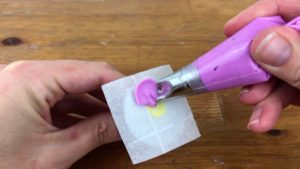
Continue all the way around the parchment to pipe a flower, starting and finishing each petal in the middle of the flower nail.

Use a small round tip to pipe a dot or a few dots in the middle of the flower to finish it.

Pull the parchment carefully off the nail and put it on a baking tray or a cutting board and place that in the fridge or freezer to chill and set the flower.
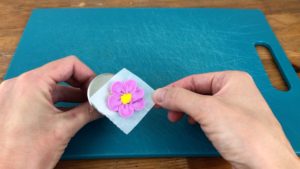
Frost your cake or cupcake and then immediately, while the frosting is still sticky, take the flower out of the fridge or freezer. Slide an
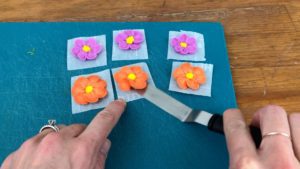
Press the flower onto the frosting to attach it. To attach the flower to a cake, if the frosting on the cake has already set you can spread or pipe a dot of fresh frosting onto the cake to act as glue to attach the flower.

If you’re interested in more ways to pipe flowers with frosting, click here for my tutorial on 8 buttercream flowers.

4. Buttercream cut-outs
This is one of my favourite techniques! Spread buttercream onto parchment paper, which you can tape onto a cutting board or you can just hold it in place. Spread the buttercream as smooth as you can, and then put the cutting board with the parchment paper and buttercream into the freezer for 30 minutes or the fridge for an hour.

When the buttercream is cold and hard, cut the buttercream out with cookie cutters or a knife. If the shapes lift up with the cookie cutters, gently push them out to release them.
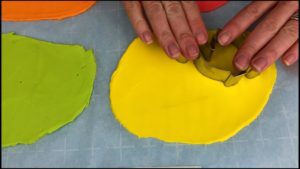
If the shapes stay attached to the parchment paper, use a knife or
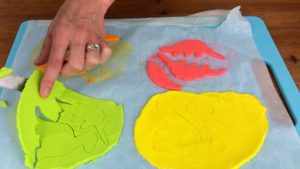
If the buttercream has started to warm up and soften since you took it out of the fridge or freezer, put it back to chill it again so that the shapes harden. Then lift the shapes up with an
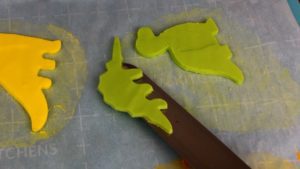
Press the shapes into the frosting on a cake. The frosting on the cake needs to be fresh and sticky for this, so that the shapes attach. If the frosting has already set you can spread some fresh buttercream onto the cake where the shape is going to go to attach it.
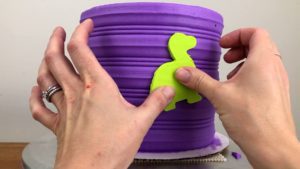
I have a very detailed tutorial on this technique with several variations like stripes and mosaic designs and rainbow or ombre patterns and you can watch it here.
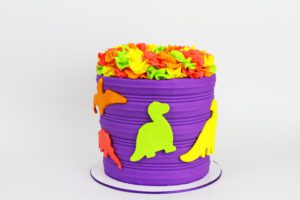
5. Chocolate sails
For chocolate sails, melt some chocolate or candy melts at 50% power in the microwave so that they don’t burn and seize. Pour them onto a piece of parchment paper that’s at least as big as the sail you want to make.
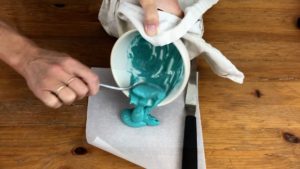
Spread the chocolate around with an
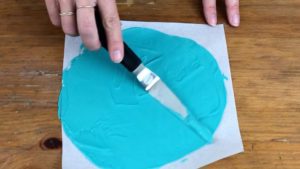
Arrange the parchment inside a bowl, letting it buckle and wave to give the sail some movement. To create an open, bowl-shaped sail, don’t let different sides of the sail touch each other.

Another way to set the sail is to drape it over something like a bottle, arranging the parchment to give the sail the shape you want it to have. Let it set at room temperature for about an hour or if you’re impatient like I am, you can put it in the fridge to speed up the process!

When the chocolate has set, peel it from the parchment paper and arrange it on your cake!
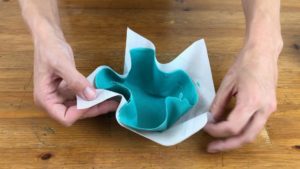
Click here for my detailed, step by step tutorial on Chocolate Sails 5 Ways.
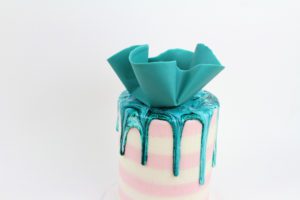
6. Chocolate cake wraps
To wrap a cake in chocolate, measure a piece of parchment so that it’s at least as high and as the cake or taller if you want it to be, and long enough to wrap around it with a bit of overlap, maybe half an inch.

Melt some chocolate and my favourite way to do this is in the microwave for a minute at a time at 50% power, stirring after each time, so that the chocolate doesn’t burn and seize. Pour the melted chocolate over the parchment paper.
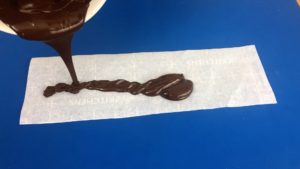
Spread it all over the paper, going right up over the edges, and don’t worry about getting it smooth because this side is going to be pressed against the cake so you won’t see it. The thicker the chocolate is, the less fragile for the next step, so don’t spread it too thin.

Now you’ll need a crumb coated cake. The frosting on the cake doesn’t need to be perfect for this since you’ll be covering it with chocolate, but the cake does need to have straight sides and the shape you want it to have because the chocolate will mold onto that shape. Lift the parchment paper with chocolate up, sliding your hands underneath it.
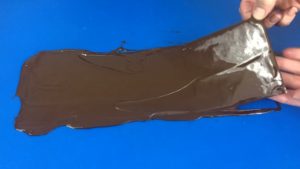
Rest the bottom of the paper down on the cake board to line it up and lift upwards to press it against the side of the cake. The comb coat needs to have set for this, so I put my cake in the fridge for an hour before this step.

Wrap the chocolate all the way around the cake, making sure the bottom of the parchment rests on the cake board so that there isn’t any cake exposed at the bottom. You can do this with any shape of cake and I’m doing heart for this one. For a circle this is simple – just press it all the way around the cake, but for a shape with angles like this heart you can pinch the parchment at the point at the bottom of the heart so that the chocolate doesn’t curve around it instead of forming that sharp point.

Put the cake in the fridge to chill and set the chocolate for about an hour and then carefully peel the paper off, starting with a corner at the top because that’s the easiest to pinch, and as the parchment peels off you’ll leave a smooth chocolate wall around your cake!
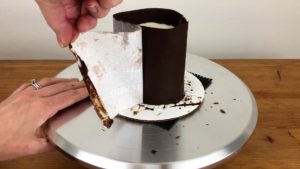
You can decorate this however you like, like with a ribbon tied around it and using cake toppers is fun – I put a variety of chocolates on top of this one.

Store the cake in the fridge until about 2 hours before serving it so that the chocolate doesn’t melt.
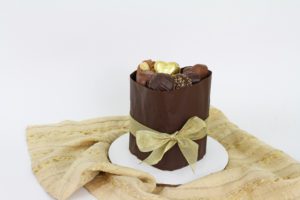
To cut into it neatly, dip a sharp knife into hot water before each slice.
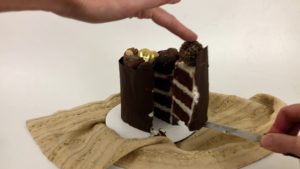
If you prefer to watch a video of this tutorial, click the play button below:
